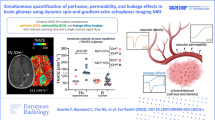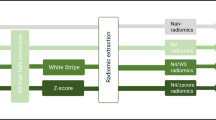Abstract
Objectives
The aim of this study was to clarify the relationship between tumor hypoxia and microscopic diffusion capacity in primary brain tumors using 62Cu-Diacetyl-Bis (N4-Methylthiosemicarbazone) (62Cu-ATSM) PET/CT and diffusion-weighted MR imaging (DWI).
Methods
This study was approved by the institutional human research committee and was HIPAA compliant, and informed consent was obtained from all patients. 62Cu-ATSM PET/CT and DWI were performed in a total of 40 primary brain tumors of 34 patients with low grade glioma (LGG, n = 13), glioblastoma (GBM, n = 20), and primary central nervous system lymphoma (PCNSL, n = 7). 62Cu-ATSM PET/CT parameters and apparent diffusion coefficient (ADC) obtained by DWI were compared.
Results
High intensity signals by 62Cu-ATSM PET/CT and DWI in patients with GBM and PCNSL, and low intensity signals in LGG patients were observed. An inverse correlation was found between maximum SUV (SUVmax) and minimum ADC (ADCmin) (r = −0.583, p < 0.0001), and between tumor/brain ratio (T/Bratio) and ADCmin for all tumors (r = −0.532, p < 0.0001). Both SUVmax and T/Bratio in GBM were higher than LGG (p < 0.0001 and p < 0.0001), and those in PCNSL were also higher than GBM (p = 0.033 and p = 0.044). The ADCmin was lower in GBM (p = 0.011) and PCNSL (p = 0.01) than in LGG, while no significant difference was found between GBM and PCNSL (p = 0.90).
Conclusion
Tumor hypoxia assessed by 62Cu-ATSM PET/CT correlated with microscopic diffusion capacity obtained by DWI in brain tumors. Both 62Cu-ATSM PET/CT and DWI were considered feasible imaging methods for grading glioma. However, 62Cu-ATSM PET/CT provided additional diagnostic information to differentiate between GBM and PCNSL.




Similar content being viewed by others
References
Graeber TG, Osmanian C, Jacks T, et al. Hypoxia-mediated selection of cells with diminished apoptotic potential in solid tumours. Nature. 1996;379:88–91.
Shweiki D, Itin A, Soffer D, et al. Vascular endothelial growth factor induced by hypoxia may mediate hypoxia-initiated angiogenesis. Nature. 1992;359:843–5.
Jensen RL. Brain tumor hypoxia: tumorigenesis, angiogenesis, imaging, pseudoprogression, and as a therapeutic target. J Neurooncol. 2009;92:317–35.
Le Bihan D, Breton E, Lallemand D, et al. MR imaging of intravoxel incoherent motions: application to diffusion and perfusion in neurologic disorders. Radiology. 1986;161:401–7.
Warach S, Chien D, Li W, Ronthal M, et al. Fast magnetic resonance diffusion-weighted imaging of acute human stroke. Neurology. 1992;42:1717–23.
Pierpaoli C, Righini A, Linfante I, et al. Histopathologic correlates of abnormal water diffusion in cerebral ischemia: diffusion-weighted MR imaging and light and electron microscopic study. Radiology. 1993;189:439–48.
Khayal IS, Vandenberg SR, Smith KJ, et al. MRI apparent diffusion coefficient reflects histopathologic subtype, axonal disruption, and tumor fraction in diffuse-type grade II gliomas. Neuro Oncol. 2011;13:1192–201.
Murakami R, Hirai T, Sugahara T, et al. Grading astrocytic tumors by using apparent diffusion coefficient parameters: superiority of a one- versus two-parameter pilot method. Radiology. 2009;251:838–45.
Barajas Jr RF, Rubenstein JL, Chang JS, et al. Diffusion-weighted MR imaging derived apparent diffusion coefficient is predictive of clinical outcome in primary central nervous system lymphoma. Am J Neuroradiol. 2010;31:60–6.
Higano S, Yun X, Kumabe T, et al. Malignant astrocytic tumors: clinical importance of apparent diffusion coefficient in prediction of grade and prognosis. Radiology. 2006;241:839–46.
Hoigebazar L, Jeong JM. Hypoxia imaging agents labeled with positron emitters. Recent results. Cancer Res. 2012;194:285–99.
Fujibayashi Y, Taniuchi H, Yonekura Y, et al. Copper-62-ATSM: a new hypoxia imaging agent with high membrane permeability and low redox potential. J Nucl Med. 1997;38:1155–60.
Imam SK. Review of positron emission tomography tracers for imaging of tumor hypoxia. Cancer Biother Radiopharm. 2010;25:365–74.
Wen B, Burgman P, Zanzonico P, et al. A preclinical model for noninvasive imaging of hypoxia-induced gene expression; comparison with an exogenous marker of tumor hypoxia. Eur J Nucl Med Mol Imaging. 2004;31:1530–8.
Nunn A, Linder K, Strauss HW. Nitroimidazoles and imaging hypoxia. Eur J Nucl Med. 1995;22:265–80.
Martin GV, Caldwell JH, Graham MM, et al. Noninvasive detection of hypoxic myocardium using fluorine-18-fluoromisonidazole and positron emission tomography. J Nucl Med. 1992;33:2202–8.
Sheehan JP, Popp B, Monteith S, et al. Trans sodium crocetinate: functional neuroimaging studies in a hypoxic brain tumor. J Neurosurg. 2011;115:749–53.
Lewis JS, Sharp TL, Laforest R, et al. Tumor uptake of copper-diacetyl-bis(N(4)-methylthiosemicarbazone): effect of changes in tissue oxygenation. J Nucl Med. 2001;42:655–61.
Tateishi K, Tateishi U, Sato M, et al. Application of 62Cu-Diacetyl-Bis (N4-Methylthiosemicarbazone) PET imaging to predict highly malignant tumor grades and hypoxia-inducible factor-1alpha expression in patients with glioma. Am J Neuroradiol. 2012;34:92–9.
Brat DJ, Van Meir EG. Vaso-occlusive and prothrombotic mechanisms associated with tumor hypoxia, necrosis, and accelerated growth in glioblastoma. Lab Invest. 2004;84:397–405.
Louis DN, Ohgaki H, Wiestler OD, et al. The 2007 WHO classification of tumours of the central nervous system. Acta Neuropathol. 2007;114:97–109.
Fujibayashi Y, Cutler CS, Anderson CJ, et al. Comparative studies of Cu-64-ATSM and C-11-acetate in an acute myocardial infarction model: ex vivo imaging of hypoxia in rats. Nucl Med Biol. 1999;26:117–21.
Read SJ, Jackson GD, Abbott DF, et al. Experience with diffusion-weighted imaging in an acute stroke unit. Cerebrovasc Dis. 1998;8:135–43.
Lewis JS, McCarthy DW, Welch MJ, et al. Evaluation of 64Cu-ATSM in vitro and in vivo in a tumor model. J Nucl Med. 1999;40:177–83.
Yuan H, Schroeder T, Bowsher JE, Dewhirst MW, et al. Intertumoral differences in hypoxia selectivity of the PET imaging agent 64Cu(II)-diacetyl-bis(N4-methylthiosemicarbazone). J Nucl Med. 2006;47:989–98.
Schlegel U, Schmidt-Wolf IG, Deckert M. Primary CNS lymphoma: clinical presentation, pathological classification, molecular pathogenesis and treatment. J Neurol Sci. 2000;181:1–12.
Barlow CH, Harken AH, Chance B. Evaluation of cardiac ischemia by NADH fluroescence photography. Ann Surg. 1977;186:737–40.
Guo AC, Cummings TJ, Dash RC, et al. Lymphomas and high-grade astrocytomas: comparison of water diffusibility and histologic characteristics. Radiology. 2002;224:177–83.
Matsushima N, Maeda M, Umino M, et al. Relation between FDG uptake and apparent diffusion coefficients in glioma and malignant lymphoma. Ann Nucl Med. 2012;26:262–71.
Buchbender C, Heusner TA, Lauenstein C, et al. Oncologic PET/MRI, Part 1: tumor of the brain, head and neck, chest, abdomen, and pelvis. J Nucl Med. 2012;53:928–38.
Buchbender C, Heusner TA, Lauenstein C, et al. Oncologic PET/MRI, Part 2: bone tumors, soft-tissue tumors, melanoma, and lymphoma. J Nucl Med. 2012;53:1244–52.
Acknowledgments
The authors declare that they have no conflicts of interest. We thank Tsuneo Saga, Masayuki Inubishi, Toshimitsu Fukumura, and Yasuhisa Fujibayashi of the Diagnostic Imaging and Molecular Probe Groups, Molecular Imaging Center, National Institute of Radiologic Sciences, Chiba, Japan; Hidehiko Okazawa of the Department of Radiology, Biomedical Imaging Research Center, Faculty of Medical Sciences, University of Fukui, Fukui, Japan; and Hirofumi Fujii, Functional Imaging Division, Research Center for Innovative Oncology, National Cancer Center Hospital East, Chiba, Japan, for their assistance. We also thank our nuclear medicine technologists for acquiring PET/CT scans. This work was also supported (in part) by a Grant-in-Aid for Cancer Research (21-5-2) from the Ministry of Health, Labour and Welfare.
Author information
Authors and Affiliations
Corresponding author
Rights and permissions
About this article
Cite this article
Hino-Shishikura, A., Tateishi, U., Shibata, H. et al. Tumor hypoxia and microscopic diffusion capacity in brain tumors: A comparison of 62Cu-Diacetyl-Bis (N4-Methylthiosemicarbazone) PET/CT and diffusion-weighted MR imaging. Eur J Nucl Med Mol Imaging 41, 1419–1427 (2014). https://doi.org/10.1007/s00259-014-2714-x
Received:
Accepted:
Published:
Issue Date:
DOI: https://doi.org/10.1007/s00259-014-2714-x




